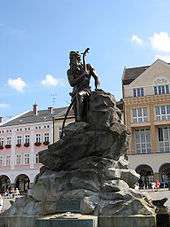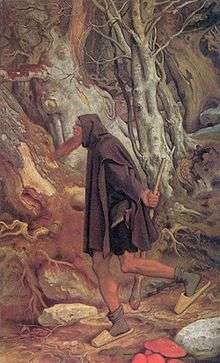Rübezahl

Rübezahl (Polish: Liczyrzepa, Czech: Krakonoš) is a folklore mountain spirit (woodwose) of the Krkonoše Mountains (Giant Mountains, Riesengebirge, Karkonosze), a mountain range along the border between the historical lands Bohemia and Silesia. He is the subject of many legends and fairy tales in German and Czech folklore.
Name

The origin of the name is not clear. One interpretation is from the story How Rübezahl Got his Name, by Johann Karl August Musäus, which recounts how Rübezahl abducted a princess who liked turnips (German: Rübe). The princess gets very lonely there in the mountains. To keep her company, Rübezahl turns the turnips into her friends and acquaintances. As the turnips wilt after a little while, so do the persons that were created by Rübezahl's magic. The princess asks him to count (zählen) the turnips in the field. While he counted, she escaped.[1]
Another proposed etymology is Riebezagel, from a combination of the personal name Riebe and the Middle High German zagel, meaning "tail", from his pictorial representation as a tailed demon.
Rübezahl is a name of ridicule, the use of which provokes his anger. The respectful name is "Lord of the Mountains" or "Lord John". The Czech name, Krakonoš, is simply derived from the name of the mountains. In Poland a lottery under the name "Liczyrzepka" existed. In one Silesian folktale, he is called "Prince of the Gnomes".[2] 1911 Encyclopaedia Britannica gives him the moniker “Number Nip.”[3]
Legends
"...Rübezahl, you should know, has the nature of a powerful genius: capricious, impetuous, peculiar, rascally, crude, immodest, haughty, vain, fickle, today your warmest friend, tomorrow alien and cold; ...roguish and respectable, stubborn and flexible...
—Musäus, 1783
In legends, Rübezahl appears as a capricious giant, gnome, or mountain spirit. With good people he is friendly, teaching them medicine and giving them presents. If someone derides him, however, he exacts a severe revenge. He sometimes plays the role of a trickster in folk tales.[2]
The stories originate from pagan times. Rübezahl is the fantastic Lord of Weather of the mountains and is similar to the Wild Hunt. Unexpectedly or playfully, he sends lightning and thunder, fog, rain and snow from the mountain above, even while the sun is shining. He may take the appearance of a monk in a gray frock (like Wotan in his mantel of clouds); he holds a stringed instrument in his hand (the storm harp), and walks so heavily that the earth trembles around him.
Near Mount Sněžka on the Czech-Polish border a botanical locality with an especially large variety of plants bears the name "Rübezahl's Garden". Some unusual stone buildings in the area are named after him as well, for example the Rübezahlkanzel an den Schneegruben.
In Czech local fairytales Rübezahl (Czech: Krakonoš) gave sourdough to people and invented traditional regional soup kyselo.[4] There is also mountain named Kotel (Polish: Kocioł, German: Kesselkoppe) which means cauldron. When fog rises from valley at bottom of the Kotel, people say that Rübezahl is cooking the kyselo.[5]
Museum

The city of Görlitz, Germany, opened the Rübezahl Museum in May 2005, thanks to the work of Ingrid Vettin-Zahn (1938 - April 10, 2006). Originally from Lauban (Lubań) in Lower Silesia, Vettin-Zahn had been expelled, and resettled in Switzerland in 1945.
In Vysoké nad Jizerou is located Krakonošovo Museum devoted to the Czech variant of Rübezahl (Czech: Krakonoš) and the region around Vysoké nad Jizerou.
Appearances in literature and other culture
Rübezahl was first mentioned in 1565 as Ribicinia in a poem by Franz von Koeckritz. The Rübezahl story was first collected and written down by Johannes Praetorius in the Daemonologia Rubinzalii Silesii (1662). The character later appeared Johann Karl August Musäus's Legenden vom Rübezahl and Carl Hauptmann's Rübezahl-Buch as well as Otfried Preußler's Mein Rübezahl-Buch. Finally, there is Ferdinand Freiligrath's Aus dem schlesischen Gebirge[6] from Ein Glaubensbekenntnis, 1844 and Robert Reinick's Rübezahls Mittagstisch. He is potentially inspiration for the character 'Huhn' in Gerhart Hauptmann's "Und Pippa Tanzt!".[7]
The poem "Count Carrots", by Gerda Mayer, is based on the tale and appears in The Oxford Book of Story Poems.[8]
In Galva IL, there was once a statue set between two buildings, dedicated to Rubezahl, enscribed, Rubezahl, the vigilant gnome who guards your home & lights your way at the end of the day. Local teenagers would toast to Rubezahl at every passing until one day Rubezahl was found missing atop his perch in between the buildings. Several theories exist, but to this day Rubezahls whereabouts are unknown.
In music
- Joseph Schuster: opera Rübenzahl, ossia Il vero amore (1789 Trieste)
- Vincenc Tuček: singspiel Rübezahl (1801 Breslau)
- Carl Maria von Weber: romantic opera Rübezahl (1805 Breslau)
- Franz Danzi: romantic opera Der Berggeist oder Schicksal und Treue (1813 Karlsruhe)
- Wilhelm Würfel: opera Rübezahl (1824 Prague)
- Louis Spohr: opera Der Berggeist (1825 Kassel)
- August Conradi: comic opera Rübezahl (1849 Berlín)
- Francis Edward Bache: operetta Rubezahl (1853)
- Friedrich von Flotow: opera Rübezahl (1852 Retzin, Groß Pankow)
- Gustav Mahler: opera Rübezahl (1879–83), music lost but libretto preserved
- Arthur H. Bird: ballet Rübezahl (1887)
- Josef Richard Rozkošný: opera Krakonoš (1889 Prague)
- Hans Sommer: opera Rübezahl und der Sackpfeifer von Neiße (1904 Braunschweig)
- Willy Czernik: symphonic poem Rübezahl (1940)
- Amon Düül II: instrumental psychedelic rock track The Return of Rübezahl on the LP Yeti_(album) (1970)
- Jan Klusák: opera pasticcio Bertram a Mescalinda aneb Potrestaná věrnost též Očarované housle Einsteinovy čili Krakonošův dar (2002 Praha)
- Dschinghis Khan: song Rübezahl from LP Helden, Schurken & der Dudelmoser (1982)
Krakonoš
Czech variant of Rübezahl, Krakonoš, in literature and other culture:
- Krakonoš was important in local old legends in Krkonoše, which have been collected literally since 1618.[9] Until today the Krakonoš plays main role in lots of regional fairy tales.[4]
- Krakonoš appeared as a main character in Czech Večerníček children's television series Krkonošské pohádky (English: Fairy Tales From Krkonoše).[10]
- Brewery located in Trutnov makes Krakonoš beer.[11]
Further reading
- Henning Eichberg: Rübezahl. Historischer Gestaltwandel und schamanische Aktualität. In: Jahrbuch der Schlesischen Friedrich-Wilhelms-Universität zu Breslau, Sigmaringen, 1991; 32: 153-178.
- Stephan Kaiser: Der Herr der Berge Rübezahl. Katalog zur Ausstellung. Königswinter-Heisterbacherrott: Museum für schlesische Landeskunde, 2000 (Hrsg.)
Notes
- ↑ Anthony S. Mercatonte, The Facts on File Encyclopedia of World Mythology and Legend, New York: Facts on File, 1988, p. 562
- 1 2 Elizabeth Knowles, ed. The Oxford Dictionary of Phrase and Fable. Oxford: Oxford University Press, 2000. Page 940.
- ↑
 Chisholm, Hugh, ed. (1911). "Riesengebirge". Encyclopædia Britannica (11th ed.). Cambridge University Press.
Chisholm, Hugh, ed. (1911). "Riesengebirge". Encyclopædia Britannica (11th ed.). Cambridge University Press. - 1 2 Kubátová, Marie (2011). Krkonošské pohádky (in Czech). Praha: Fragment. ISBN 978-80-253-1126-4.
- ↑ Pavlová, Svatava (2000). Dva tucty pohádek z Krkonoš a Podkrkonoší (in Czech). Praha: Knižní klub. ISBN 80-242-0283-2.
- ↑ Aus dem schlesischen Gebirge at Spiegel Online
- ↑ Carolyn T Dussere, The Image of the Primitive Giant in the Works of Gerhart Hauptmann (U of Kentucky Press, 1977)
- ↑ Michael Harrison and Christopher Stuart-Clark, ed. (1990). The Oxford Book of Story Poems. OUP. pp. 81–86. ISBN 0 19 276087 4.
- ↑ "KRAKONOŠ dobrý duch našich hor". freiheit.cz.
- ↑ Šimková, Božena (Writer) (1974–1984). Krkonošské pohádky (Television production). Czech Republic: Czech Television.
- ↑ "Pivovar Krakonoš Trutnov". pivovar-krakonos.cz.
External links
- Musäus: Rübezahl und das Hirschberger Schneiderlein, illustrated by Arpad Schmidhammer, Fischer & Franke, Berlin 1901 (German)
- Carl Hauptmann: Rübezahl-Buch on Projekt Gutenberg-DE (German)
- Rübezahl and music (German)
- Rübezahl – Sage und Wirklichkeit (German)
- muellers-lesezeit.de
- Rübezahl - Duch Gór - Rybecal by Ullrich Junker & Izabela Taraszczuk, Bodnegg - Jelenia Góra 2003 on Digital Library of Jelenia Góra (German) (Polish)